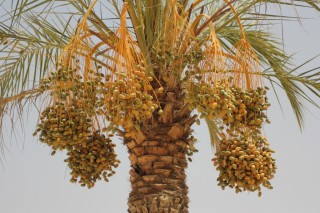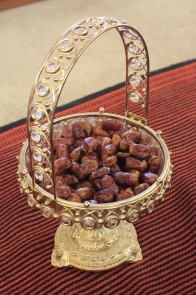 While there is some public transportation between the big cities in the Emirates, we felt like we really needed to have a car to get around sensibly and be able to reach all the places we wanted to see. Luckily, with the petrol prices on the Arab peninsula being just a fraction of what we are used to, it turned out to be a quite economical way of getting around as well. And best of all, it’s fairly straight-forward to take a rental car across the border to Oman. So we picked up a car in Dubai, drove on the impressive seven-lane highway to Abu Dhabi, and then, after getting two (!) flat tires fixed, onwards into the desert.
While there is some public transportation between the big cities in the Emirates, we felt like we really needed to have a car to get around sensibly and be able to reach all the places we wanted to see. Luckily, with the petrol prices on the Arab peninsula being just a fraction of what we are used to, it turned out to be a quite economical way of getting around as well. And best of all, it’s fairly straight-forward to take a rental car across the border to Oman. So we picked up a car in Dubai, drove on the impressive seven-lane highway to Abu Dhabi, and then, after getting two (!) flat tires fixed, onwards into the desert.
Our first destination was the Liwa Oasis, the gateway to the Rub‘ al Khali, the „Empty Quarter“. It is the largest coherent sand desert in the world and covers more than a third of the Arabian peninsula. 
 The environment here is very hostile with temperatures rising above 50 degree and water wells being very scarce. Except for Bedouin tribes who used to call the desert their home, there are only few accounts of foreigners travelling in the Empty Quarter. The most famous one is probably the British explorer Wilfred Thesinger, who crossed the Empty Quarter several times with the help of Bedouins and mapped large parts of it between 1946-1950.
The environment here is very hostile with temperatures rising above 50 degree and water wells being very scarce. Except for Bedouin tribes who used to call the desert their home, there are only few accounts of foreigners travelling in the Empty Quarter. The most famous one is probably the British explorer Wilfred Thesinger, who crossed the Empty Quarter several times with the help of Bedouins and mapped large parts of it between 1946-1950.
The Liwa Oasis had some of the expected cliché features like massive date palm plantations, camels trotting around, but also some really nice old forts. Behind the date palms, the sand dunes rise and stretch endlessly to he horizon, like an ocean with gigantic waves frozen in time. The drive to Tal Mireb, pretty much a dead-end road into the desert towards Saudi-Arabia, was spectacular. In several places it looked like the desert would swallow up the road any time, and our small car just about made it through. That’s why the Emiratis all drive Landrovers.
From time to time we saw big construction projects going on in the sand – building new pipelines, developing new oilfields. Some of the largest oil fields in the world lie beneath this ocean of sand, and while the biggest oil reserves lie within Saudi Arabian territories, the UAE got its share of oil reserves below the dunes.
On our way into Oman, we stopped for two days in Al Ain, located on the border to Oman and the fourth-largest city in the UAE (after Dubai, Abu Dhabi and Sharjah). It’s name translates as ‚the spring‘ and the city really lives up to it’s reputation as the garden city. Many parks, oases and tree-lined roads make you almost forget that you are in the middle of the desert – even though the dunes were as close as ever, and watching the sun set over the reddish coloured mountains of sand was breathtakingly beautiful. But Al Ain impressed us not only with it’s greenery, it was the first city in the UAE that felt more organic and traditional. People still trade camels here every single day, and on the camel market we watched them haggle over their livestock, check out how fast that camel really can race and wether it has good teeth. Our host Cheryl, an American teacher who works for a local school, took us with her jeep to the probably most hidden UNESCO site ever – the beehive-shaped Hafeet tombs from early civilisations that inhabited the Al Ain area about 4000 years ago.
All the oases produce an abundance of dates, and while they have been a staple food for millennia in the Middle East, to this date they are an essential expression of Arab hospitality, and people serve them to you with a small cup of black coffee. They eat them both fresh and dried. We didn’t really like the fresh ones, they taste like flour, but we loved the dried ones and stocked up on dates from the Al Ain Oasis before setting off to Oman – not that they wouldn’t have any dates there…











